Disclosure: Meeple Mountain received a free copy of this product in exchange for an honest, unbiased review. This review is not intended to be an endorsement.
“I have news for you,” said Ola, our marketing contact at Board&Dice.
We were at Gen Con 2024, and I was sitting with a fellow media member during our meeting. I looked at Ola for a moment—a moment that was maybe a hair too long, but I think she knew how excited I was about to get. “What…what is it? Are you about to tell me what I think you’re about to tell me?”
That other media member looked over at me, confused. “What are we talking about here?”
Ola smiled. It’s happening, I said to myself. It’s about to–
“Tiletum is getting an expansion!”
I stood up, screamed to the sky—OK, really just the ceiling of the Indiana Convention Center—and pumped my fist. I knew it…I KNEW IT!! Tiletum, my 2022 game of the year, was finally getting an expansion. Finally, the two men who I needed to come together to make this happen, Daniele Tascini and Simone Luciani, decided to make me (and only me, I knew it!) happy by designing additional content for a game that absolutely didn’t need it, but I wanted it, so that meant we needed it.
Tiletum: Prospect for Silver arrived on my doorstep about a month ago. Even though the box was small, the excitement I had to break that puppy open was huge. After a couple of fresh plays, I like what’s here, but it really doesn’t matter to me—any excuse to get Tiletum onto the table is the right excuse for me.
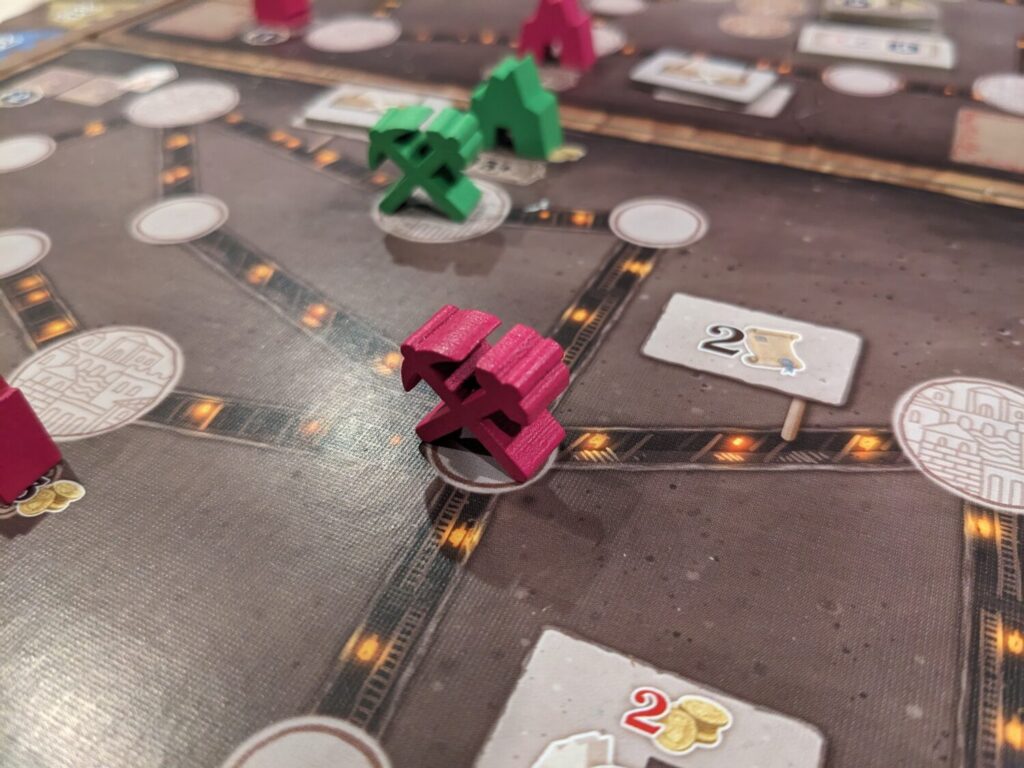
Hi Ho, Silver
Tiletum: Prospect for Silver is an expansion to Tiletum for 1-4 players. A copy of the base game is required to play this expansion. If you are not familiar with the rules to the base game, check out my earlier review.
Tiletum has been in the wild for three years now, and every time I show it to someone new, they say versions of the same things:
- “This game feels like it came out 20 or 30 years ago.”
- “Man, the dice drafting system here is really smooth.”
- “Gosh, this board is ugly.”
- “Tell me again: which die gives me iron and which one gives me stone?”
- “This is my new favorite ‘T’ game.”
Even though I was gushing earlier about the moment when I learned about the expansion, the reality is that for me and my play preferences, Tiletum is essentially a perfect game. With three players who can take reasonably quick turns, it’s bulletproof. The scoring mechanics are exactly what I want in a round-based scoring system (similar to Voidfall, where players have to focus on a round’s “Fair Phase” in order to maximize their output), the setup variability is extraordinary—ensuring that every game is a little different—and the combos are gorgeous. It’s one of the few games where I love watching other players take turns, because watching a player string together a combo that lets them take a main action and a number of different side actions is something to behold.
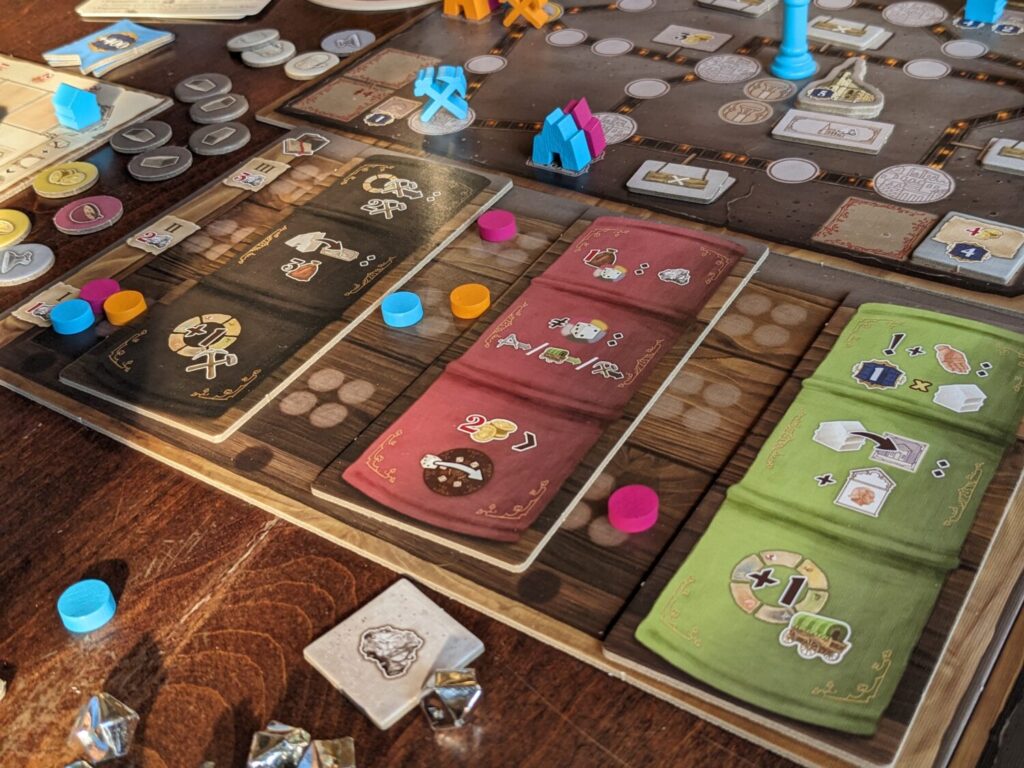
And Tiletum features the kind of Eurogame interaction I adore. In some rounds, certain resource types aren’t even available with the dice on the central rondel, so turn order is critical. Racing to build houses in certain sections of the board means that a player won’t have to plant their merchant token in a scoring location during the Fair Phase. Dice in the Joker action space offer the most flexibility, so getting one of those dice might snake another player. Scanning the board to find the best opportunities to build Cathedrals before your opponents might provide an edge later in the game.
In the original game, the only action that I might say needed some work was the King action. This is the least complicated action in the main game, and while the person ahead on the King track does get to go first in the following round, the rewards can sometimes be a bit opaque. Sure, I might get myself a few points instead of losing a few points, but in a game where winners usually surpass 200+ points, will it really hurt to lose five points this round?
Often, players ignored the King track, although in a recent play of the base game, a friend tried a different tactic by going hard on the King track once during each round. With a boosted action thanks to a “completed building” and smartly triggering the King action when it was at its maximum action point area of the rondel (six action points), this person was able to sometimes move up seven spaces on that track all at once, in a game where a player holds their King track position between rounds as long as they stay on the positive side of that points track.
The expansion content provides two new mechanics, beyond the addition of what I’ll broadly call “more stuff”—more bonus tiles, more Fair Phase scoring tiles, a new guild crest, some new contracts, etc. And of course, we get silver. Let’s talk about the new goodies!

The Prospector Action (and the Prospector Movement Bonus)
Tiletum: Prospect for Silver adds three new “Underground” boards to the setup. On its own, this is a bit of a pain, because Tiletum’s main board plus each player’s personal mat was already a stretch of my limited table space. The addition of these new Underground tiles boosts Tiletum into “massive table hog” territory. During a recent three-player game of this expansion, we needed almost two full tables at a bar to get all our stuff into the play area.
The three Underground boards represent maps where mines can be built to harvest silver, a new component to the Tiletum system. On each of the three Underground boards (and each board is double-sided, increasing setup variability), a player can place a Prospector token to take actions on each Underground board.
Prospector tokens act like a combination of the Merchant and Architect tokens from the base game. On the Underground boards, there are spaces to build houses, construct Cathedrals, take bonus tiles, and place mines in new, dedicated spaces. Prospector tokens can complete all of these tasks. Mines immediately produce silver (a component, but not a resource like the game’s five base resources), and that silver is used for a variety of game effects, including the completion of certain contracts, conversion to gold, and the technologies we will come to later.
The Prospector tokens can be moved around each Underground board with action points, just like the Merchant and Architect tokens. Certain paths on those boards can be navigated by crossing Stone Tablet spaces that, in true Tiletum fashion, offer the active player another bonus in the form of points or actions or even more silver. However, once a player has passed a Stone Tablet space, they cover that bonus so that no one else will receive it later.
The Prospector action is located on a new action wheel, which comes as a part of the expansion’s new board overlay that covers the action wheel and King track from the base game. (Essentially, this new board covers the leftmost third of the original game board.) The new Prospector action is always set up adjacent to two of the main actions from the base game during a round, so that the dice pool from those two actions is also available to be chosen for the Prospector action.
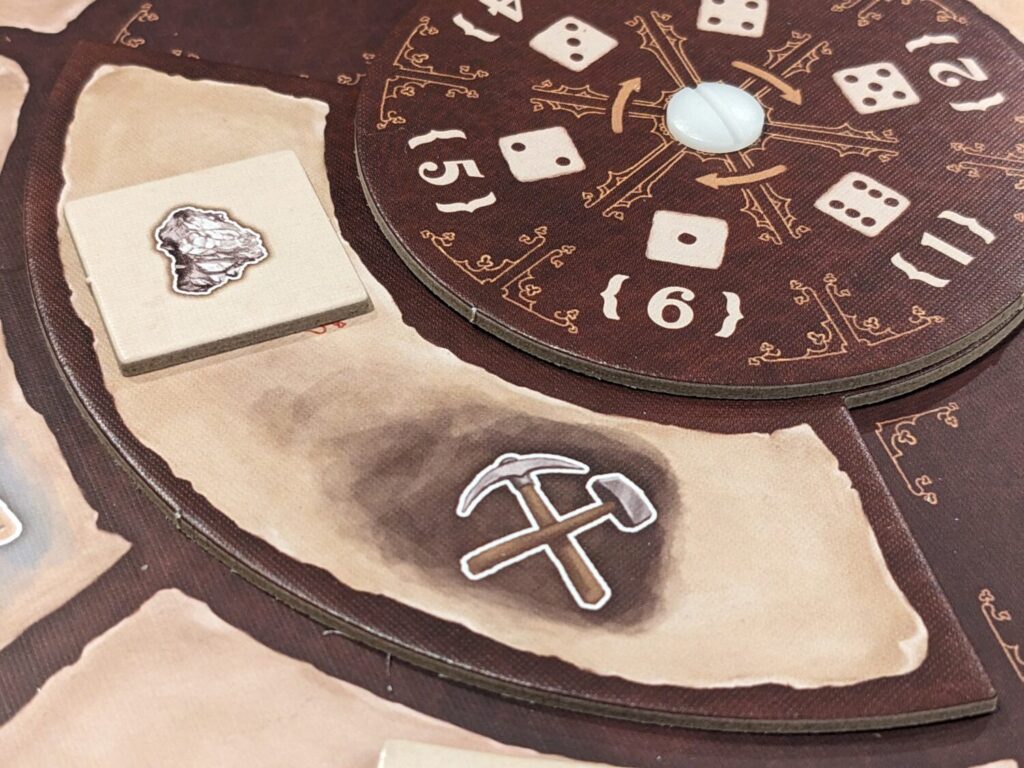
In this way, a player has a choice during their turn—take a die from one of the six main actions, or take a die from one of the two wedges where the Prospector action is currently aligned. There is also a new task on the action wheel, aligned with the two wedges opposite from the Prospector action area. This new task allows a player to move one of their Prospector tokens one space as a bonus to one of the two main actions in the outer ring (the actions from the base game), which might trigger a Stone Tablet bonus.
None of this was confusing to new players, which was a relief. It looks a little wonky on the board but in terms of execution, it only took a few turns for players to pick up on what the game was trying to do. (The worst thing about the new board overlay is that it makes the whole enterprise a little janky. In each of my plays, someone bumped the overlay, which isn’t sexy on a board that already isn’t winning many awards with people despite its excellent functionality.)
The Prospector action does help supercharge the scoring mechanics on display here, in a game that already featured very high scores. If Prospector-specific goals are in play—notably the Fair Phase goals tied to mine placement—players will go hard on placing mines underground or going after all the various goodies on the Underground maps. Even with a single Prospector in each round, players found ways to move their tokens around the map to claim a couple of Stone Tablet bonuses, build a Cathedral or two, and grab a bunch of the Underground bonus tiles.
But prospecting is all about getting more silver, because silver is the only way to boost a player’s standing on the technology board. I’m not sure if I need to have the Prospector business in the game, but I need that silver because the Technology Board is insane fun.
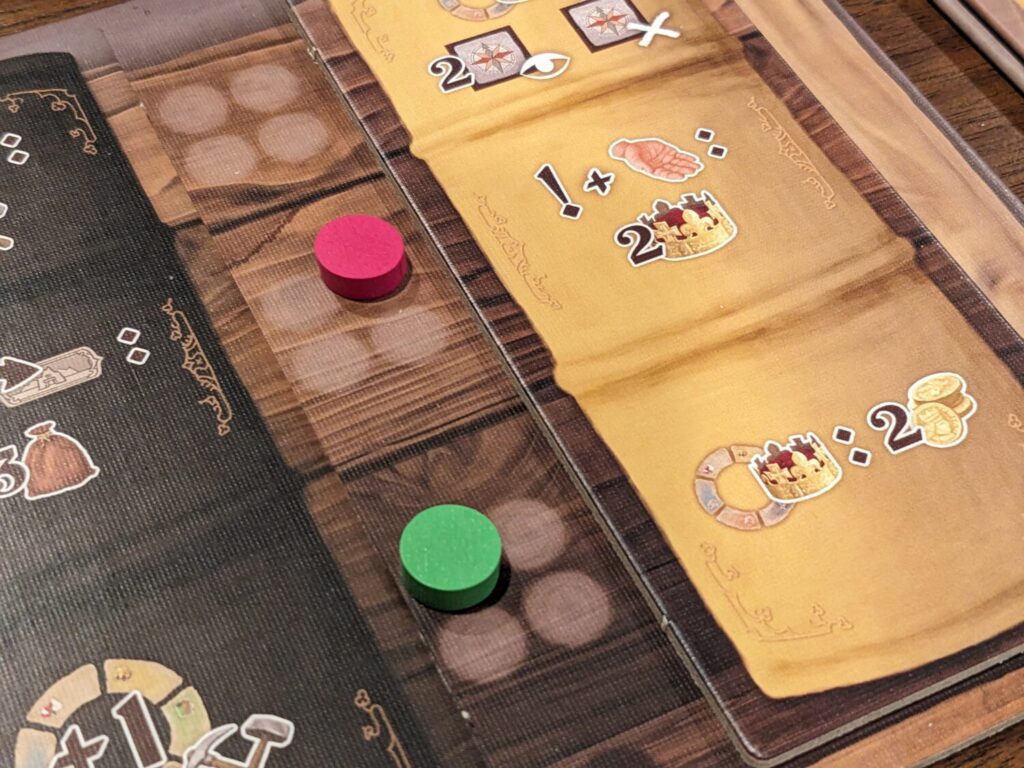
The Technology Board
The fourth new board added to the play area, beyond the three Underground boards, is the Technology Board. This board holds the three Technologies that are available in a given game of Tiletum: Prospect for Silver. In another nod to the game’s hallmark, the setup variability here is quite handsome—there are nine different Technologies in the box, but only three will be available in any one game.
Each Technology is focused on either a particular mechanic or a particular action. That means that there are seven action Technologies (Merchant, Architect, Prospector, Contract, King, Joker, Character) and two additional ones, to benefit anything tied to gaining resources or manipulating dice.
As a free action, players can pay silver to boost their levels on the tech tracks. For one silver, a player gains access to the first level of a particular tech; spend two silver to get to level two, and so on. When a player is on a higher level of a Technology, they have access to each power at and below their current tech level, so each tech stacks quite nicely. And some of these techs are ridiculous.
So far, my favorite has been the Die Manipulation Technology. At level one, you can spend two gold to not only move a die one action away from its current location, but you can move that die up to three spaces away. That, on its own, is pretty huge, because that means that late in a round, when dice are mostly gone from the rondel, a player still has plenty of options as long as they have a little gold lying around.
Level two gets spicy. Each time you take a die with a pip count and color that you don’t already have on your player mat (which means this automatically applies to the first die you take each round), you get to move either your Merchant, Architect, or Prospector token once for free. This encourages a number of interesting mechanics: now I’m incentivized to select unique dice on my turn, but this also lets me move pieces like my Merchant around to spaces that will allow me to score during a Fair Phase or set up other actions when I take a main Merchant action later.
Level three was massive in my three-player game: when selecting a die for its resources to start a turn, a player with this tech can sacrifice one of the resources to turn that into a silver. I got this tech in the second round, then spent the rest of the game taking high-pip dice to turn one of those pips into a silver.
Suddenly, I had a silver engine. This, in addition to my mine building actions using Prospectors earlier in the game, meant that I got five silver as income between rounds two and three, then six silver as income between rounds three and four. I dumped all that silver right back into the techs for the two other Technologies in that game, which supercharged every other action I was taking.
These techs are a bonanza, and I was thankful that the techs are relatively easy to track, even if they were sometimes hard to consistently implement. The techs feel appropriately powerful, and they feel meaningful in ways that players can build strategies around. Because everyone after the first player gets one silver during setup, some players will have a handsome advantage to make up for the fact that their dice pool may be limited to start the game.
This also pushes the first player to take a Prospector action on their first turn (especially if the first round’s Fair Phase features a Prospector-aligned goal), which helps other players see the benefits of getting in on that silver game early.

A Handsome Reward for the Superfan
Tiletum: Prospect for Silver does a lot of nice things, particularly for someone like me who has surpassed 10 plays of the base game. I didn’t think I needed even more ways to score points, but this expansion’s use of the Underground boards mixed with the variety of the Technology tiles has me very excited to explore the new space.
I only showed this expansion to one new-to-Tiletum player, but I enjoyed his commentary after that first play. “I like that this expansion is easy to incorporate, so it wasn’t overwhelming, but now I am curious to play only the base game.” I personally won’t be using the expansion with other new players in the future—the base game is plenty for me, and it doesn’t overwhelm new players because the rules overhead is just right.
Quality of life additions to the base game come in the form of badly-overdue player aids. (I still can’t believe the base game didn’t come with any aids…remember, every game needs a player aid.) The expansion has aids and now I have a very easy way of teaching the base game to new players. The player aids have all the expansion info needed as well, but the cards do a great job of calling out the specific areas where they deal with expansion goodies.
One big surprise with the expansion: it comfortably fits into the base game’s box. I didn’t even have to get that creative to get it all in there, so I have already tossed the expansion box into the recycling bin.
I don’t think Tiletum: Prospect for Silver sits on hallowed expansion ground, similar to what Terraforming Mars: Prelude does for that game. I’ll still happily play base Tiletum or Tiletum with the expansion, and I will mix and match based on the audience. I have a few friends in my network who love the base game and have also played it a dozen times or more, so for that group, I’ll break out the expansion. For anyone else—particularly on a game night where I want a slightly shorter version of the game—it’s base game only.
Depending on your group, plan accordingly. It was incredible getting Tiletum back to the table in any form, and I love the new twists and turns of this expansion. If I never get any additional Tiletum content, I’ll die a happy man. (And, if I get a few more promos or bonus tiles or extra contracts, I’ll die a little happier!)


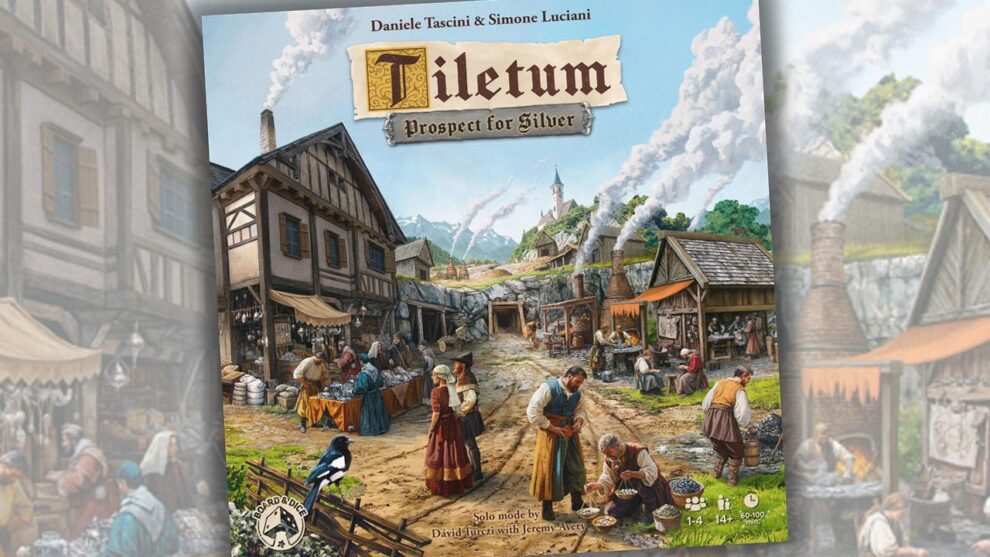

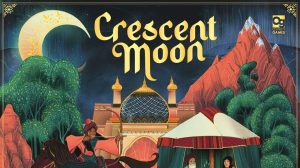
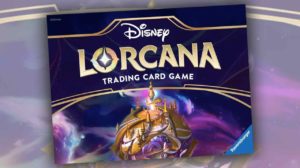



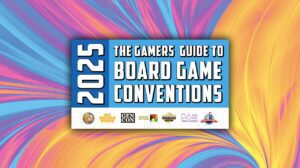
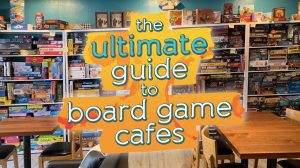
Add Comment